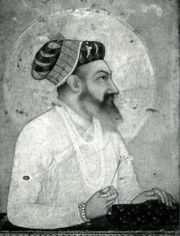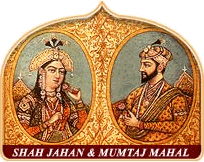Shah Jahan
Shahab Uddin Muhammad Shah Jahan I ( January 1592 – 22 January 1666) was the emperor of the Mughal Empire in India from 1628 until 1658. The name Shah Jahan comes from Persian meaning "king of the world." He was the fifth Mughal ruler after Babur, Humayun, Akbar, and Jahangir. While young, he was a favourite of his legendary grandfather Akbar the great. He is also called Shahjahan The Magnificant.
Even while very young, he could be pointed out to be the successor to the Mughal throne after the death of Emperor Jahangir. He succeeded to the throne upon his father', Emperor Jahangir's death in 1627. He is considered to be one of the greatest Mughals and his reign has been called the Golden Age of the Mughals. Like Akbar, he was eager to expand his empire. The chief events of his reign were the destruction of the kingdom of Ahmadnagar (1636), the loss of Kandahar to the Persians (1653).
Between 1636 and 1646, Shah Jahan sent Mughal armies to conquer the Deccan and the northwest beyond the Khyber Pass. Even though they aptly demonstrated Mughal military strength, these campaigns drained the imperial treasury.
As the state became a huge military machine and the nobles and their contingents multiplied almost fourfold, so did the demands for more revenue from the peasantry. Political unification and maintenance of law and order over wide areas encouraged the emergence of large centers of commerce and crafts--such as Lahore, Delhi, Agra, and Ahmadabad--linked by roads and waterways to distant places and ports. The world-famous Taj Mahal was built in Agra during Shah Jahan's reign as a tomb for his beloved wife, Mumtaz Mahal. It symbolizes both Mughal artistic achievement and excessive financial expenditures when resources were shrinking.
The economic position of peasants and artisans did not improve because the administration failed to produce any lasting change in the existing social structure. There was no incentive for the revenue officials, whose concerns primarily were personal or familial gain, to generate resources independent of dominant Hindu zamindars and village leaders, whose self-interest and local dominance prevented them from handing over the full amount of revenue to the imperial treasury. In their ever-greater dependence on land revenue, the Mughals unwittingly nurtured forces that eventually led to the break-up of their empire.
In 1658 he fell ill, and was confined by his son Emperor Aurangzeb in the citadel of Agra until his death in 1666. On the eve of his death in 1666, the Mughal Empire spanned almost 750,000,000 acres (3,000,000 km2) and he was the most famous and powerful man on earth of the age who had in his empire the biggest and the most prosperous capital (Shahjahanabad) and some of the most delicate architectural masterpieces of the world. The period of his reign was the golden age of Mughal architecture. Shah Jahan erected many splendid monuments, the most famous of which is the legendary Taj Mahal at Agra built as a tomb for his wife Empress Mumtaz Mahal (birth name Arjumand Banu Begum). The Pearl Mosque and many other buildings inside the Red Fort (Qila Mubarak) at Agra , the complete design of the Old Delhi (Shahjahanabad), the palaces, the Red Fort and the great mosque at Delhi, mosques in Lahore, buildings in the Lahore fort (present day Pakistan) and a beautiful mosque at Thatta (present day Pakistan) also commemorate him.
Once the most famous, celebrated and the luxurious throne of the world, the Takht-E-Taus or the Takht-E-Shahanshah-E-Hindustan (Peacock Throne), said to be worth millions of dollars by modern estimates; it dated from his reign. It was carted off to Persia where its gold was melted and its precious jewels were removed. It no longer exists.
Shah Jahan was also the founder of Shahjahanabad, now known as 'Old Delhi'. The important buildings of Shah Jahan were the Diwan-i-Am and Diwan-i-Khas in the fort of Delhi, the Jama Masjid, the Moti Masjid and the Taj. It is pointed out that the Palace of Delhi is the most magnificent in the East.(Mahajan, Vidya Dhar (1970). Muslim Rule In India. p. 286)
| These articles deal with Mughal Empire |
|
Babur (1526-30) -|- Humayun (1530-56) -|- Akbar (1556-1605) -|- Jahangir (1605-27) -|- Shah Jahan (1627-58) -|- Aurangzeb (1658-1707) |


